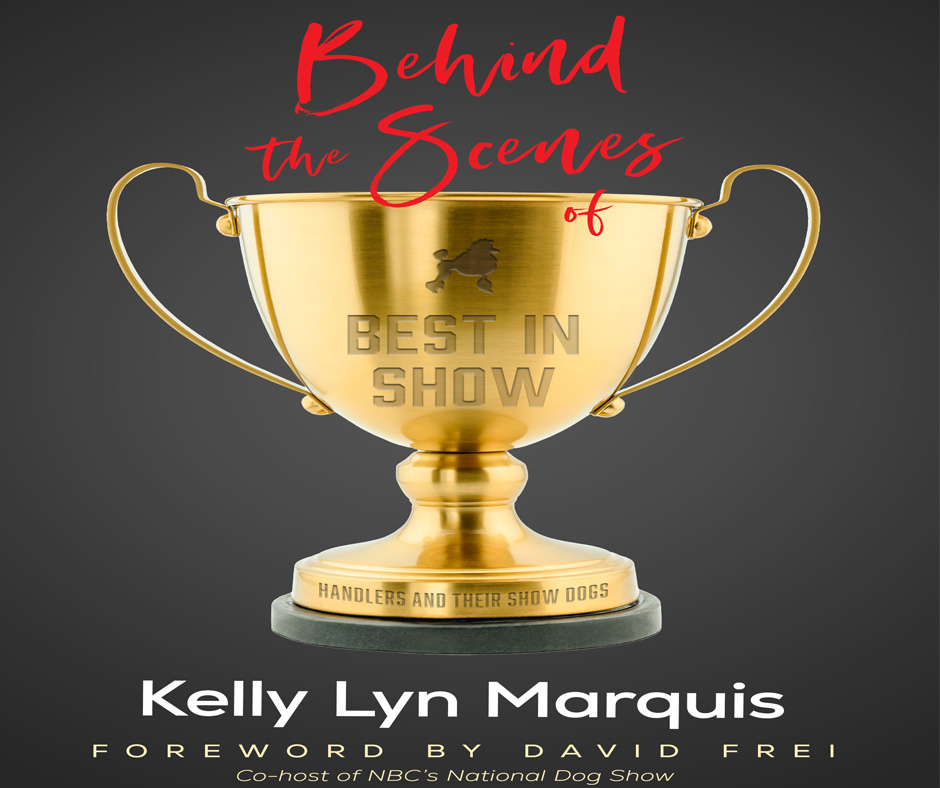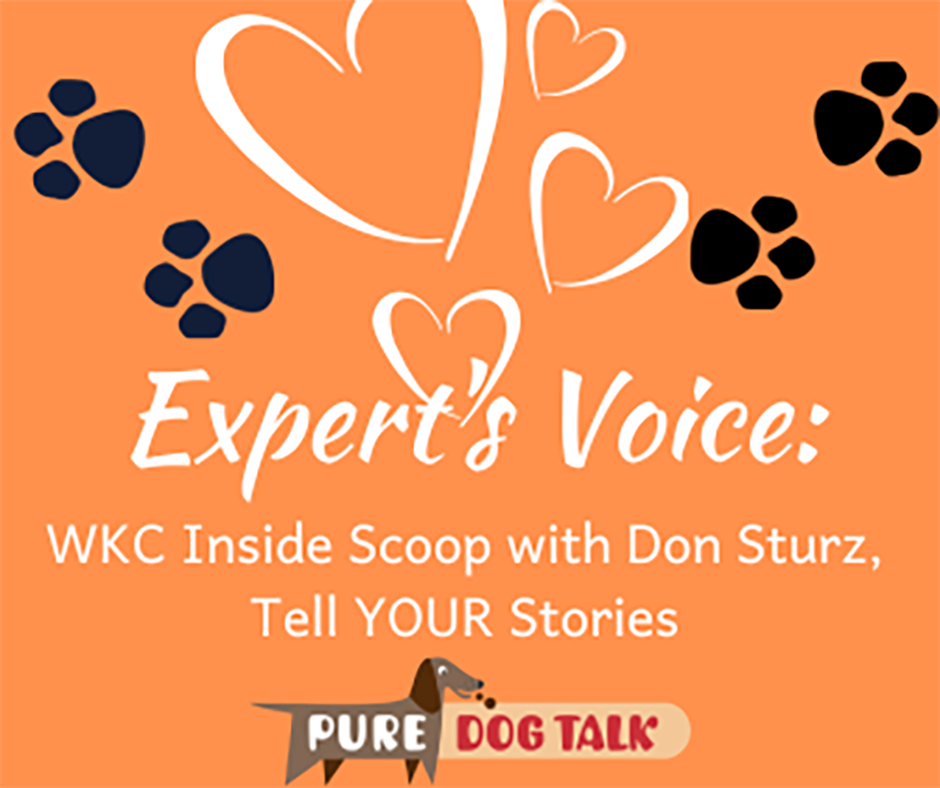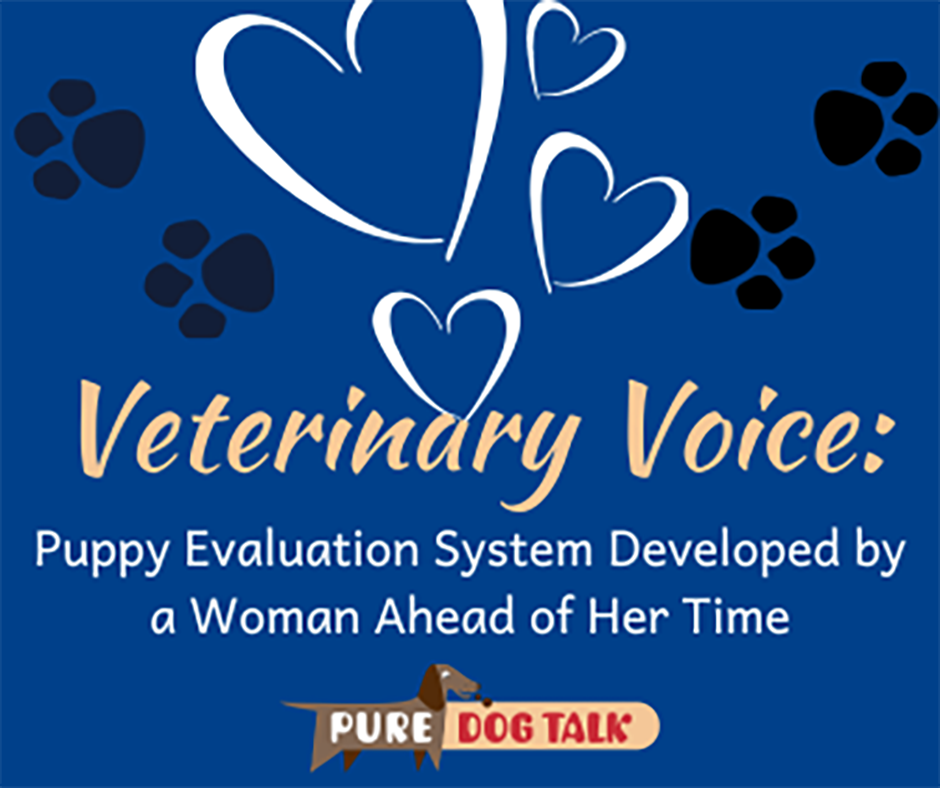Posts by Laura Reeves
627 – Tools to Help Protect Vulnerable Victims
Tools to Help Protect Vulnerable Victims

Pam Bruce, judging in Orlando.
Host Laura Reeves is joined by Pam Bruce, a 32-year veteran of the Toronto Police Department where she was a sex crimes investigator. Pam was also Canada’s first acknowledged expert in this field.
With recent arrests that have dramatically impacted the purebred dog world, everybody’s asking what the American Kennel Club is doing. Pam is the individual who has trained all of our AKC reps, staff and board members already.
Her presentation from which today’s podcast is drawn will be available to everyone in Canine College starting this month. Today’s episode is an excerpt of this critically important presentation. Watch the full conversation HERE.
“We can all be empowered by knowledge,” Reeves said, “and the knowledge that Pam has to share is what is going to make us all more able to handle the situations that we’ve been handed.”
“Sex assault itself (is) intimate sexual contact with a person without their consent,” Bruce said. “And a young person does not have the capability of offering consent, the same as somebody that’s vulnerable. (It may be) accompanied by force or even threat of force …
“It’s not for sexual gratification of an offender. It’s all about power and control. But the big problem for us in our sport is it’s living in the gray areas, and that comes from non-reporting. The first time an offender was caught is not the first time they offended. And when you speak to the experts about this, they say on the low end, the average of sex assaults that have been committed before an offender has been even on their radar is at least seven.
“So let me just drill down a bit with vulnerable victims. A vulnerable person can be identified as someone who belongs to a group within our society, so think of dog shows, that is either oppressed or more susceptible to harm.
“Anyone under the age of 18 years, or an older (person) who has an impairment due to physical, mental, or emotional function. One who is unlikely, unable, or incapable to report grooming, sexual abuse, physical abuse, or neglect situations.
“Now let it not be lost on anyone that the offender is the one that chooses the victim. And it’s often for that exact reason that that person has a lack of capability and if they do have capability or someone to assist with that reporting, will they be believed? We must report on their behalf or assist them to do so.
“The bigger issue for us and for society is what about the undetected offenders? Due to non -reporting, we don’t know what we don’t know. Child victims know their offender 94 percent of the time.
“These people are our village, but there are victims in our village and offenders in our village and we know them, we love them. We believe we know their full being, but does anyone ever really know anyone?
“’Grooming behaviors’ is the idea of a perpetrator forming relationships with children. If you see an adult and they’re really not friendly with a set of parents, but they’re spending a lot of time around their children, I periscope up right away. I want to know why or if it’s somebody vulnerable, someone disabled. If they’re helping them, that’s wonderful. But there is a line that should not be crossed, which is the next point, testing boundaries. Perpetrators will try to test boundaries on your child’s comfort level.”
626 – Kelly Lyn Marquis Shares Her Insights from the Masters
Kelly Lyn Marquis Shares Her Insights from the Masters

Kelly Lyn Marquis in the ring.
Host Laura Reeves is joined by Kelly Lyn Marquis to discuss the stories in Marquis’ new book Behind the Scenes of Best in Show: Intimate Moments with the Masters.
“When I started writing (the book),” Marquis said, “I was seeing some dissension, sometimes some frustration where I would hear people saying things about handlers doing all the winning and you know I really really wanted to show all of the work that goes into those wins.
“And even even for many of us that you see in the book, for so many of the masters, it’s not about the wins. Actually, not one of them, not one of them, mentioned about the win being something that matters to them. It’s the behind the scenes things that matter to them whether it’s making their clients happy or the connection that they have with that dog. And that was a motivation.
In her conversation with Michael Scott, Marquis admits struggling to understand his thinking.
“…(T)o Michael, it is his job to handle the dog to the (best of his) ability and to bring that dog to the right judges. And he knows his judges well. He knows what they like, as did Gwen (DeMilta). (B)ut Michael’s job was to handle. Well, there wasn’t the messiness that I would see in Gwen, and that also was active in myself as well.
“So when I interviewed Michael and Michael said, ‘My job is to handle the dog and to bring it to the right judges. Period.’ And he even went on to say that, ‘Look, it’s a game.’ And that really triggered me ’cause I thought, ‘No, this is serious business!’ And it isn’t that Michael doesn’t take it seriously, but he’s very clear on what his role is as a handler.
“That was one of the things that really struck me interviewing Michael, was if Michael had been my mentor and if I operated and navigated the dog show world with Michael’s mindset, how might my… my life be different? So that is one of the values that I think a reader can get from reading this book where when you see where someone’s priorities are and how that shapes how they navigate the world…
“When it comes to the passion and the emotional attachment, I always give credit to the owner handlers and let them know that when it comes to my own dog, I have to have another handler show it because it gets messy.
“One of the things that I love about handlers that I think is a lesson for, well, even for ourselves to bring out into the world, but we’re masters of our emotion. It’s like you, okay, we look at this, what do I need to be? How do I need to show up for this dog?
“And we’re very clear about that. We have a very clear role and we’re able to be in integrity and we’re also able to look at that dog and go, okay, what’s going on with you? You and I, we need to… make this work. We don’t have the luxury to have an emotional moment,
“Which also gets me thinking about another motivation for my book. I wanted to show our humanity because when we’re at a dog show, we need to be in business mode. We’re not showing our… our feelings.
“You know, Michelle Scott talks about how difficult it can be for her at times, managing her expectations and how she knows she wants to make people happy. And it can be so disappointing when you’re not able to make that person happy. But we can’t show that we have to show up and we have to be professionals. But it doesn’t mean that we don’t feel things. It just means that we’re in business mode, we can’t be getting caught up in those places, but we do have feelings just like everyone else.
“Another motivating factor for me is this is our community. I’m looking around it it’s scary it looks like a dying community. I believe that this is an underlying theme in my book as well is that we are people. There are people at the ends of those leads and we need to be taking care of ourselves and our community better. One of the things that I’ve learned. Being a mom is my number one priority. And if my work is getting me so strung out that when my daughter comes home from school I can’t hold space for that because I’m too agitated myself, then I’m not able to be the mom that I want to be. And so even as handlers, when we show up at our job, are we making good choices for ourselves so that we can serve not only ourselves but more people?”
625 – What to Do at WKC from the Queen of Queens
What to Do at WKC from the Queen of Queens
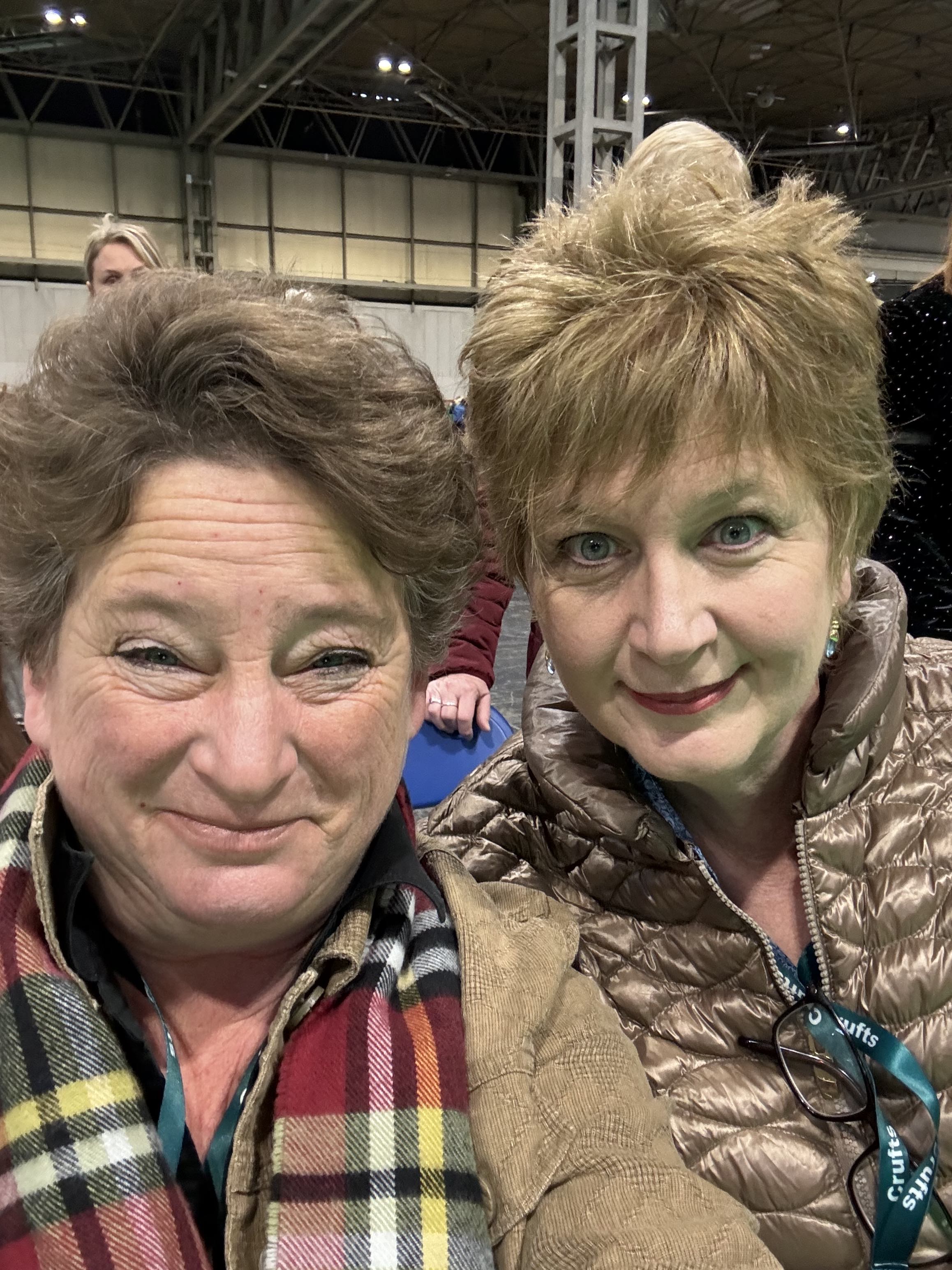
Host Laura Reeves and Denise Flaim at Crufts ’24.
Denise Flaim, lifelong resident of Queens, joins host Laura Reeves with a personal guided tour of what to do while at Westminster Kennel Club, slated for May 11, 13-14 at the USTA Billie Jean King National Tennis Center in Queens.
“Queens is not like Manhattan, first of all,” Flaim said. “Queens scares people, I think because like all the boroughs, it’s not laid out in a grid pattern …. OK, so there are street names, the streets curve and all this. Well, you know, New York is the city of neighborhoods. And if you know the neighborhood, you can find your way around. So I’m going to give you a couple of neighborhoods to go to.
“Let me preface this by saying don’t drive anywhere people. OK? First of all, you’re not going to find parking. Second of all, you have a 37% chance of being involved in an incident of road rage… And then you’ve got to know how to parallel park…. So take an Uber. They’re everywhere.

The Parkside in Queens is a historic Italian restaurant.
“First of all, you’ve got the Parkside restaurant, OK? Parkside Restaurant is probably one of the few remaining white tablecloth, red sauce, old Italian restaurants. It’s phenomenal. You go in there, you order a glass of wine or carafe of wine and you get your eggplant parm. And it’s going to be very New York. It’s going to be lots of neighborhood guys. It’s going to be a typical New York City Italian restaurant. The likes of which has basically been eradicated off the face of the earth. But this is the real deal.

Bocce games in Spaghetti Park are quintessential New York.
“After you have your amazing meal at the Parkside, you’re going to go one block to the Lemon Ice King of Corona, from which that television show got its name, and apparently it’s been featured on The King of Queens or whatever. You’re going to order. You don’t have to just have a lemon ice. You could have a spumoni ice. You can have a chocolate ice. It goes on forever and ever. Pistachio, my personal favorite. Then you’re gonna take your ice …. and you’re going to go across the street to what is called Spaghetti Park. In the right weather, you will find the Bocce courts above, with septuagenarian and octogenarian Italian men in their slouchy sweaters and their caps playing Bocce. You will then not disturb the bocce play just because that’s not going to end well. You’re not going to ask to play, but you’re going to watch because really, that, is New York.
“Now for something completely different. Flushing, Queens. You can go to Chinatown in Manhattan. But just as amazing is the Chinatown in Flushing, Queens. And I want you to go to a place called the New World Mall … on your right you’re going to see this Asian supermarket that’s got everything. I don’t want you to be distracted by the supermarket. You can get that on the way up. I want you to go down the escalator. To the subterranean food court that has every (food) you could possibly want, every cuisine.
“It has Chinese, Japanese, Thai, Vietnamese, Taiwanese. You name it, it’s there. You can get pho. You can eat bullfrog. There are all the amazing Chinese aunties making hand done dumplings, hand rolled. Bubble tea, the whole thing. OK? It is amazing. You would never know that it is there. But I think it’s well worth an excursion.
Listen to the full episode to hear more of Denise’s personal guided tour of Queens.
624 – At-Home Early Cancer Detection Test Hits the Market
At-Home Early Cancer Detection Test Hits the Market
Chan Namgong, founder of Oncotect, joins host Laura Reeves for a very personal discussion of the value of early cancer detection for our dogs.
Namgong launched his company in 2019 in the aftermath of his mother’s cancer diagnosis. He already knew that dogs can detect human cancer by scent. But then he learned about a group of scientists that discovered that small nematodes can detect cancerous metabolites in urine in human medicine.
“What’s amazing about these small nematodes is that they have very high sense of smell,” Namgong said. “They have more olfactory receptors than dogs, despite their small size. So what we have done is we’ve developed a platform where we are using (nematodes) to detect cancerous metabolites in dogs’ urine that contains the cancerous metabolites.
“(Nematodes) are small worms, and the scientific name of them is C. elegans. And C. elegans is actually, you know, if you are a scientist or biologist, it’s a model organism. It’s widely used in different disciplines of science. In pharmacology, chemistry, biology, you know, cancer cells, stem cell research, environmental study, because we know everything about these worms. In fact, C. elegans was the very first multi-cell organism that was ever DNA sequenced. And the way we utilize them is we can actually measure the intensity of the olfactory neuron in their head.
“We can categorize pets as low, moderate or high risk of cancer. Oncotect is a screening test, not a diagnostic test. So, this is meant to be proactive and preventive measure. And then if there’s any risk, moderate or high risk, we’ll bring you back to your veterinarian for further consultation, diagnostic tests such as x -rays or ultrasound to really confirm or deny a cancer suspicion or to identify the type and location.
“Prevention of cancer is almost impossible because we don’t know what’s really truly causing cancer. But your best strategy is find it early and treat it quickly. Diagnosing a cancer is like a putting a puzzle together. You’ve got to bring different pieces of information to really look at a big picture.
“We have primarily focused on the four most common treatable canine cancers. They are lymphoma, melanoma, hemangiosarcoma and mast cell tumors. And the reason why we focus on those four is because just due to the limited resources that we have.
“We’ve tested over 700 dogs in the last year or so. And among those 700 dogs, we have detected TCC, bladder, prostate, liver, soft tissue. So we’ve detected other cancer types, but the reason why we are not making claims for them is because we haven’t run a large enough sample size to publish any scientific paper on them, which we plan to do this year.”
623 – Managing Your New Puppies’ Critical First 72 Hours
Managing Your New Puppies’ Critical First 72 Hours
Dr. Marty Greer, DVM joins host Laura Reeves to discuss managing the critical first 72 hours with new puppies.
A recurring theme with breeders and new litters is the term “fading puppy.”
“(Fading puppy) is basically we’re just lumping a bunch of stuff together and calling it fading puppy,” Greer said, “because we don’t necessarily have a confirmed diagnosis. We may not have a diagnosis yet. We may never have a diagnosis, but it is not a diagnosis. It’s just a description of a puppy that fails to thrive. And I think that a better term is failure to thrive rather than fading puppy because it’s more clear that it’s not really a term of diagnostics.
“I think a lot of owners and veterinarians tend to kind of throw up their arms and say, ‘well, it’s a sick puppy. I don’t really know what to do with it.’
“Well, there’s a lot of things you can do. Diagnostically, you can do almost everything to a small puppy that you can do to a big dog. Now of course the bigger the puppy gets, the easier it is to do the diagnostics. But if you choose to pursue some of these diagnostics, it’s not that difficult. You can do an x -ray, you can do an ultrasound, you can do blood work. At the very least, do a glucose level.
“Worst case scenario, you lose a puppy. Don’t just put it in the freezer and walk away, take it to your veterinarian, ask them to either open it up for you or send it in for diagnostics.
“We’ve found things that are clearly one -offs. We’ve seen like the puppy doesn’t have an intestinal tract, a large intestine. Okay, that’s not gonna affect every puppy in the litter. But if you have herpes, if you have adenovirus, if you have distemper, if you have E. coli, if you have all these different kinds of diseases, the faster you can get a specific diagnosis and get a specific treatment put together, the better.”
Greer observed that puppies who fail to thrive may present as crying constantly or weak and not moving with the “swarm” of the litter. Dehydration and low body temperature are common and correctible issues that can knock a puppy down and even out in the first 72 hours.
Test hydration by monitoring urine color, Greer recommends, and be prepared to administer subcutaneous fluids if needed. Listen to the full episode as she walks listeners through this process and more.
622 – CRUFTS! Preview with breeder, exhibitor, judge Sharon Pinkerton
CRUFTS! Preview with breeder, exhibitor, judge Sharon Pinkerton
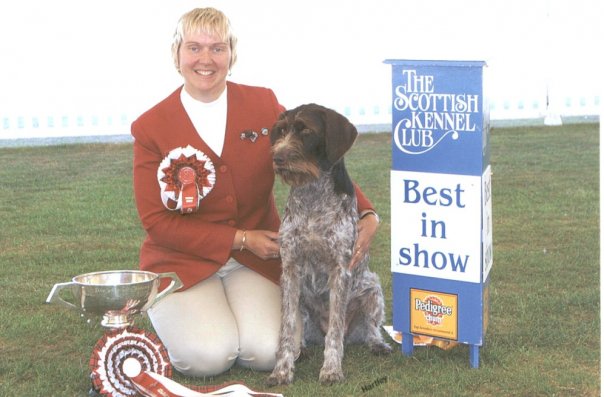
Sharon Pinkerton with one of her 66 champion GWP.
Sharon Pinkerton, Bareve GWP, joins host Laura Reeves to preview the Crufts dog show held in Birmingham, England on March 7-10.
Pinkerton, who was raised with Greyhounds and English Cocker Spaniels, will judge Spinoni Italiano and the Breeders Competition finals at the show.
“Originally launched on 15 January 2009, the prestigious breeders’ competition, sponsored by Agria Pet Insurance, gives breeders the opportunity to showcase their skills and knowledge as a breeder,” according to the Crufts website. “Each year a number of qualifying heats take place at general and group championship shows. Teams compete to gain points by being placed between 1st – 4th.
The top 40 teams will qualify for the final at Crufts, of which two positions will be for the breeders’ competition winners from the European and world dog shows.”
“I’ve judged German Wirehaired Pointers (at Crufts) a long time ago. And I’ve also judged Hungarian Wirehaired Vizslas. But this has been a little while since I’ve been asked to judge at Crufts. And certainly the first time I’ve been asked to do anything like the breeders (competition).
“It is still quite a new competition. I’m probably the first true exhibitor that’s been asked to judge it. The last four years have been top all-rounders where they’ve had breeding experience but they are more considered now to be an all-round judging person as such rather than still a breeder exhibitor. So I feel quite special really to be at that level.
“I think that’s what I’m looking forward to most is actually doing that because I know it’s such an achievement to be asked. When I first got the email invite and I opened it and looked and I just thought no this is a mistake people like me we don’t get invited for these sort of things. I dutifully sent it back thinking it would just come back saying ‘I’m really, really sorry Sharon, but it was wrong.’ But it came back as yes, you’re now confirmed.”
Sharon decided German Wirehaired Pointers were the breed for her and acquired one from the second litter ever born in the UK. Since the mid ‘70s she has produced 66 champions, of which 12 are full champions, where the dogs have proven their ability in the field as well as the show ring.
“Dogs that have a job to do are considered to be show champions until they’ve actually been out in the field to prove their gun dog worthiness,” Pinkerton said, “plus of course the Border Collie which is the only herding breed that are show champions until they actually go and prove their ability to herd.
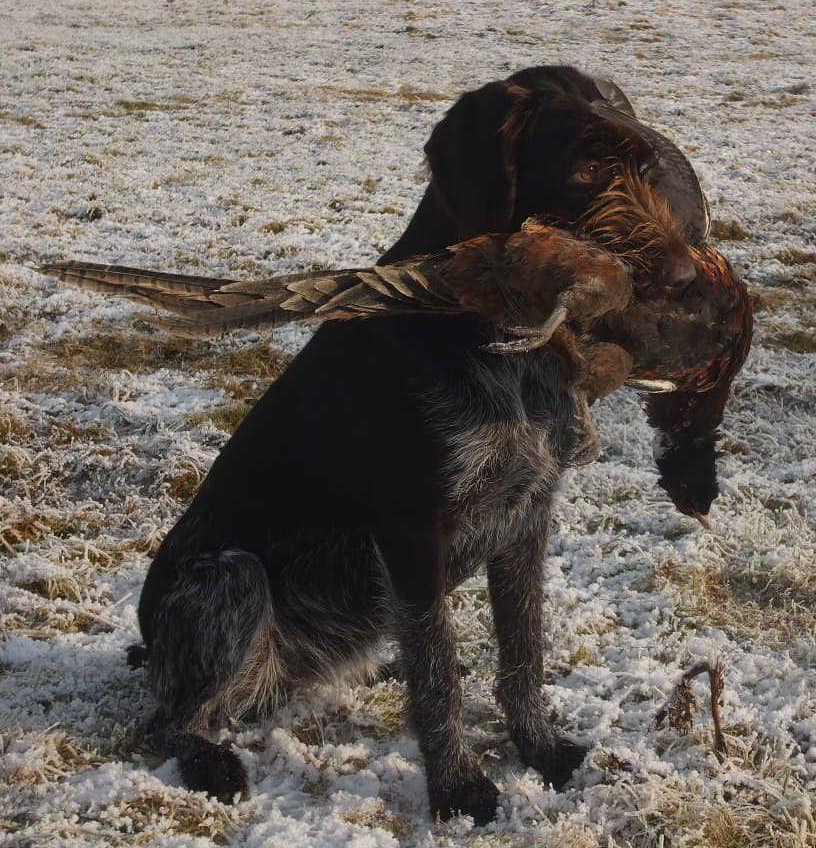
Champion Bareve Blaauboskom JW in the field.
“So all the gun dogs, no matter what breed they are, are all show champions unless you then go out into the field and prove that they are capable of doing the job that they were bred to do. And then we can proudly knock off the show bit and then they become full champions.
Listen in to the entire interview for more details and insights about the famous Crufts dog show.
621 – Gatekeeping Within Our Breeds: A Conversation with the Patrons
Gatekeeping Within Our Breeds: A Conversation with the Patrons
Host Laura Reeves is joined by members of the Pure Dog Talk Patrons group in an extended deep dive on the question of gatekeeping within our breeds. Members of this private group share their opinions, thoughts and mitigations on placing dogs, using limited registration, educating puppy buyers and more.
Spinning off a podcast conversation several years ago with Amanda Kelly on the topic of are we protecting our breeds into extinction, Laura and the members of the group discuss the various perspectives on the topic.
“This is a group where we talk about a lot of things and very rarely do we share those things into the public realm,” Laura noted. “But we all thought this was a pretty important topic and that we all had things we wanted to say about it and we wanted to share that with the larger Pure Dog Talk community as a podcast.”
One side of the conversation is the position that we have a lot of problems with new people coming to dogs and you have a new person who’s excited to do it and the gatekeeping is preventing them from doing so.
On the other side of the discussion is the opinion shared by a long-time breeder in the group.
“I do not want my only okay, mediocre dogs in the conformation ring. That is not my goal. I don’t care how many champions I do or don’t finish as a kennel,” Karyn Cowdrey said. “What I care about is that what represents my kennel be of, in my opinion, sufficient quality. I would be proud to have kept it I would be proud to walk into the ring with it and honestly if I deem it show ring worthy to me then it’s breeding quality and I keep my name on that dog until at least a certain amount of criteria are met by that person if they’re a new person.”
Education of new and potential buyers was also frequently mentioned in the dialogue.
“I’m very big on education,” Sandy MacArthur said. “And I can give an example and I will not name the person nor the breed, but there’s a person who went in the dog world and was looking for a ‘breeding pair’ … this was 30 years ago in the 90s… emailing everybody ‘I’m looking for a breeding pair’… We all know that’s an instant red flag and this person got put on everybody’s do not sell list.
“Someone in the breed she was interested in decided to take this person out to lunch and have a conversation. By the end of the conversation at lunch, she sold that person a bitch on a co -owned contract. This person put all the work into it, all the research, drove everywhere every weekend, did everything right, and 30 years later is a well -known dog person. Let’s just say that. Somebody took their time to pull them aside ’cause they didn’t know. They thought that what you do is you get a breeding pair. They had no idea.”
If you would like to join these types of conversations, as well as support the work of the podcast in education and mentoring, please visit the website and sign up to join us! Go to https://puredogtalk.com/patron/ to learn more.
620 – WKC Inside Scoop with Don Sturz, Tell YOUR Stories
WKC Inside Scoop with Don Sturz, Tell YOUR Stories
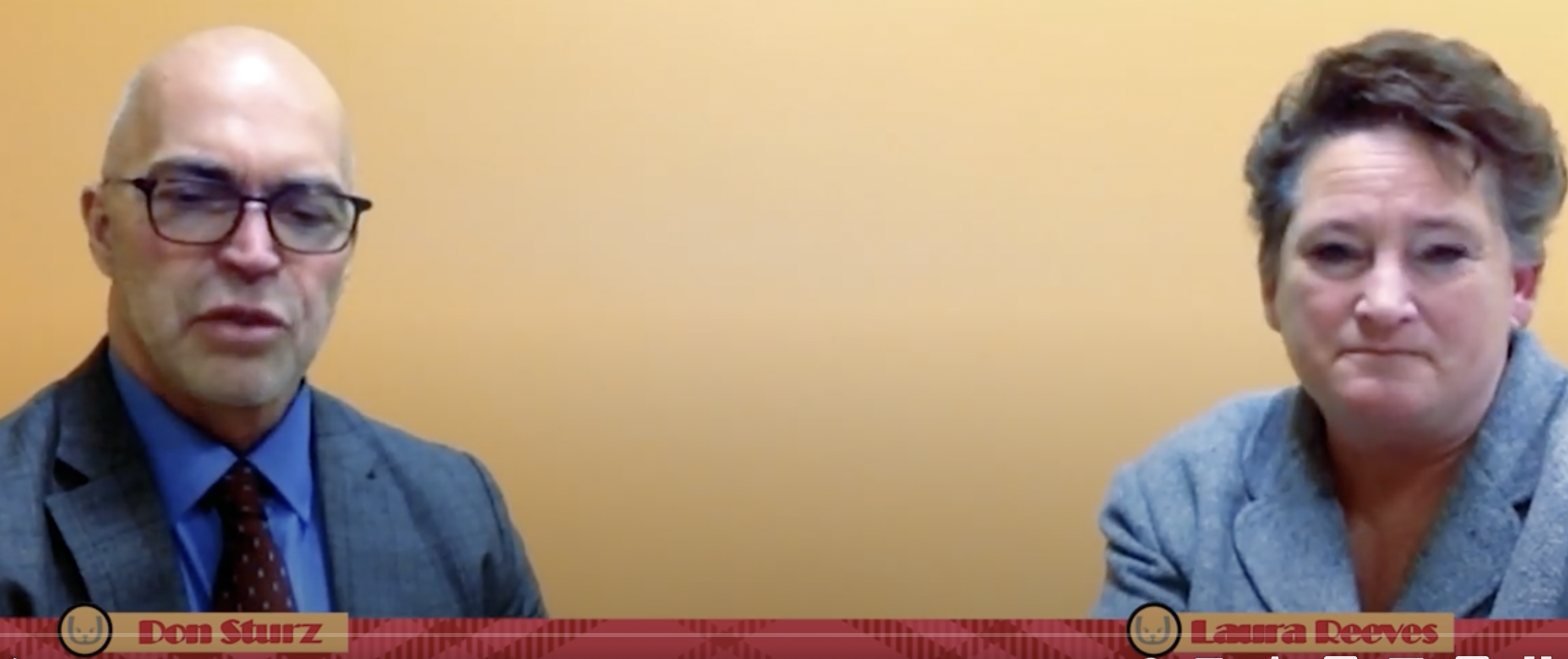
Don Sturz and host Laura Reeves sit down at the Rose City Classic to discuss the 2024 Westminster Kennel Club dog show and plans for the future.
Dr. Donald Sturz joins host Laura Reeves to discuss this year’s Westminster Kennel Club dog show at the Billie Jean King Tennis Center in Queens, NY and plans for the future.
This year the club will celebrate the 90th anniversary of Junior Showmanship, Sturz noted, while the show is dedicated to the memory of Dave Helming. Sturz describes the search for new turf, new bracing over the courts for the outdoor rings, a gelato stand, an outdoor bar and new ticketing resources for evening events.
“We want to be respectful and pay homage to the history and the tradition of Westminster, but at the same time, attempt to move forward and remain relevant,” Sturz said. “Always keeping the experience for the dogs and the exhibitors as the priority. And it’s not always easy to juggle that.
“Will we ever be back in Madison Square Garden? That’s what you all want to know. Everybody wants to know, will we ever go back to the Garden?
“Okay, so my standard answer has been for the past year, never say never. Remember, I grew up in this. I showed at Westminster for the first time when I was 10 years old … I’ve moved to calling it Westminster because we’re not calling it the Garden … so I’d like to get back to being able to say “the Garden” so it is something that we’re working on.
“The fact of the matter is Madison Square Garden was remodeled and when they did that remodeling it’s what took away all that space. So there’s no way to have a daytime event. So that’s how we ended up with the Piers. So then that thing called covid hit and during that time Pier 92 fell into the water … so that’s gone. Pier 94 is actually being remodeled and will no longer be an exhibition space. It’s going to be smaller spaces for individual businesses and so on.
“So the Piers are off the table. (We) really basically looked at every possible venue in New York City or the metropolitan area. You know, we went to Newark … we had to exhaust everything, right? We also went a little further out into Queens, to the Nassau border and looked at an arena there. And all of these, we kind of looked at it from a space point of view, like, how would it work, right? In Manhattan itself, it’s very limited as to what venues… like, there’s really only one.
“We’re going to be in one of those kinds of venues that’s going to, hopefully, afford us the opportunity to then be back at Madison Square Garden in the evening. So, watch for that.
“The plan is to try to find something for ‘25 that is also ‘26 because we just need to stop moving. We need our home.
“There’s lots of fabulous events in our sport, but there is nothing in the world like Westminster. There’s something magical about that event. That’s something that we consistently commit ourselves to is the Westminster experience, right? Creating that magic.
“So. I think Westminster is in a really great place. I think it’s a pivotal moment for Westminster.”
619 – Puppy Evaluation System Developed by a Woman Ahead of Her Time
Puppy Evaluation System Developed by a Woman Ahead of Her Time

Virginia Apgar, who named the newborn evaluation system.
Dr. Marty Greer, DVM joins host Laura Reeves for their ongoing puppy discussion. This month Greer shares the story of Virginia Apgar, who named a now-famous newborn evaluation system after herself.
Apgar was a human anesthesiologist who graduated from medical school in the 1930s, Greer noted.
“She was the first female anesthesiologist admitted to the College of Anesthesiology back in an era where there were no women doctors. There were no women a lot of things. So she was truly remarkable, Greer said.
“In that era, a lot of babies were born to mothers that were sedated or anesthetized. And so (Apgar) developed a scoring system to analyze the babies and it has stuck for the last 70 years and it’s very impressive that it’s something that people talk about every day, still using the word APGAR. The acronym stands for: appearance, pulse, grimace, activity and respiration.”
The system was adapted for small animal veterinary use by a vet on staff at the University of Minnesota.

Parameters for APGAR scoring.
“The advantage of a numerical score,” Greer added “is that it gives you something that you can measure and compare litter to litter, puppy to puppy within the litter over the course of time. And we have some really good data from Neocare, which we talked about last time, about what the relationship with the APGAR score and the survival of these puppies will be. So it’s actually super cool that you can take all this information and turn it into something that you can use at home, you can use at your veterinary clinic, and that your veterinary clinic can help you with. So I would encourage people to learn to do APGAR scores. It’s not hard, it’s not mysterious. It’s really pretty straightforward on what to do with it.

Treatments for common whelping issues.
“The value of this is when you go home (from a csection, for example) and you have a puppy that had an APGAR score of a four and a puppy that had an APGAR score of a nine, that you know the puppy with the four needs a lot more attention to have the kind of survival rates that one would hope for. We always hope for a hundred percent (survival), but reality is 100% is probably not a realistic goal.
“Each of the five parameters, appearance, pulse, grimace, activity and respirations gets a score of a zero, one, or a two. So collectively, if you get twos on all five of your items, you have a score of a ten.
“It’s really simple to do. It doesn’t require high level assessment and like I said, a lot of us probably are intuitively already doing this. When you have puppy born, if it’s fish breathing and gasping and gaping, that’s not good. But, if it’s got nice pink color and it’s wailing and it’s crying and it’s wiggling and it’s pink and it’s all those things, you know that you’ve got a puppy that’s in pretty good shape. But it’s just nice to be able to give it a more numerical sign because that gives you data to work with.
“The average puppy is gonna be seven and up. It does give you a numerical score. The value of this is knowing that from the Neocare information, that’s from the University at the Toulouse -France Veterinary School, the puppies with an APGAR score of less than seven have a 22-fold increased risk of death in the first eight hours after they’re born.
“And they also know that puppies with APGAR scores between a four and a seven can achieve a 90 percent survival rate with the appropriate interventions. So, what does that mean? That means you suction them, you put them in oxygen, you make sure that they’re staying warm. You’re doing all those things that you already have been trained to do to help with puppy resuscitation so that they’re not just you know laying in the whelping box kind of hoping that they do okay.”
Greer’s seminal book “Canine Reproduction and Neonatology” is available HERE.
618 – Pro Tips on Changing the Conversation from Ian Lynch
Pro Tips on Changing the Conversation from Ian Lynch
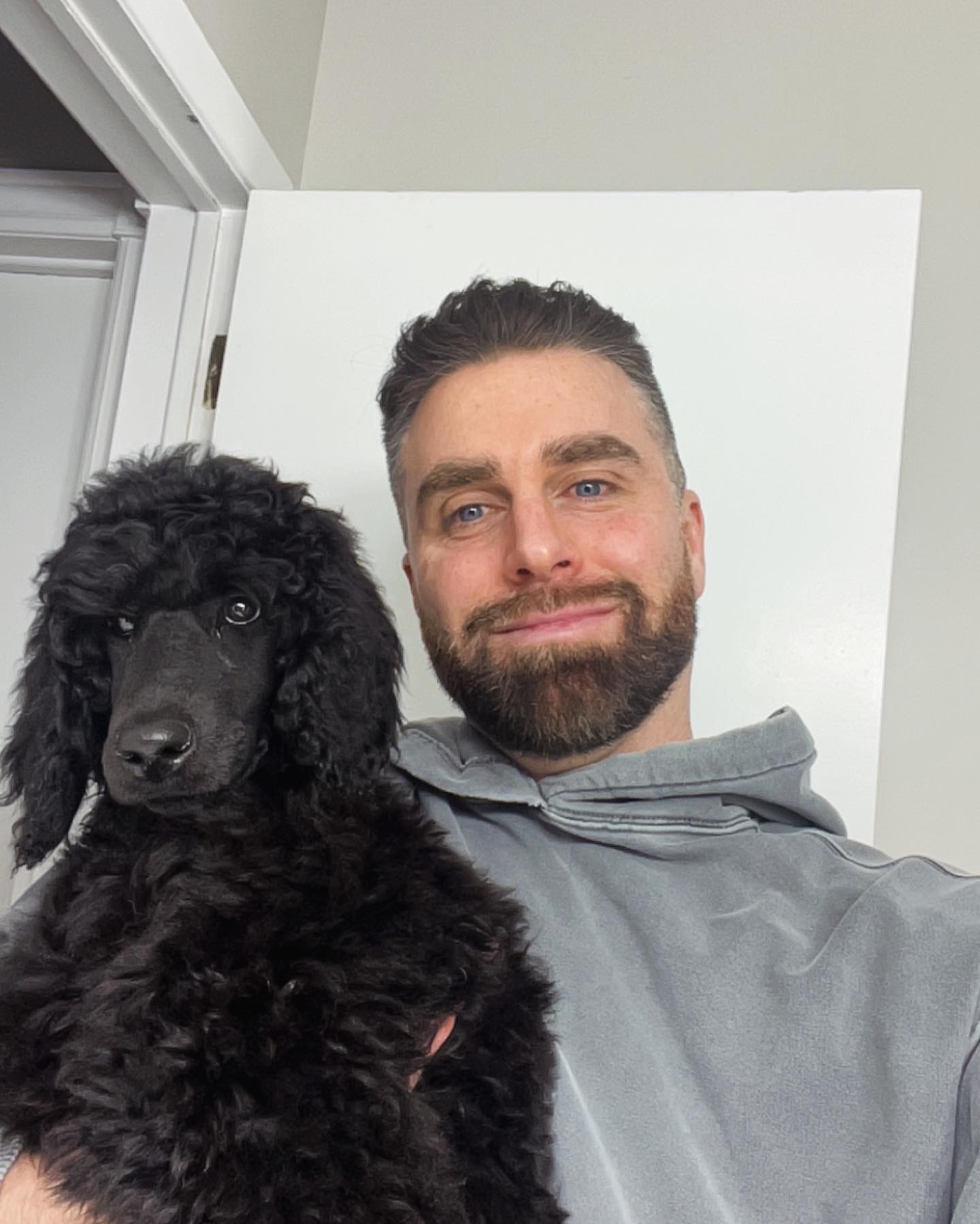
Ian Lynch with his newest Dawin Poodle, Portia.
Canadian Kennel Club spokesperson Ian Lynch joins host Laura Reeves to talk about changing the conversation on purebred dogs with the general public.
Lynch, a broadcaster in his day job, brings his passion for purebred dogs to the CKC as their public spokesman. He describes his lifelong obsession with the sport, obtaining the Dogs in Canada Annual magazine and creating a “vision board” with pages from the book taped to his wall.
His first dog as an adult was a Dawin standard poodle.
“I used to get “Dogs in Canada” annuals and I used to put all the pictures on my walls because I love these dogs. And I had a picture on my wall in 1995. It was an Allison Alexander in a red dress, holding Dawin High Falutin, who was the number one dog and has all these records to this day. His name was Lutin, I believe his call name. And it’s funny because as I get older, I realized that I was making a vision board because now I have a Dawin dog.
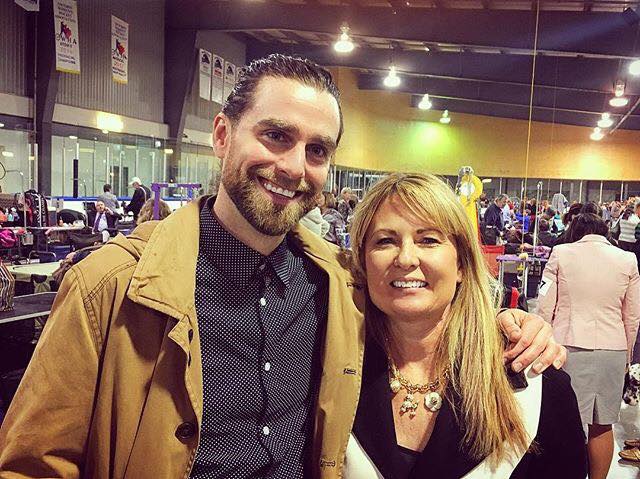
Ian Lynch and Allison Alexander, from vision board to friends.
“And I’m friends with Allison Alexander and she’s the greatest person alive. So, it’s so funny that like, you know, that you hear almost like manifestation stuff and I didn’t know what I was doing. But as a kid, I used to always have the picture of the Dawin dog and I used to tell my parents, ‘I’m gonna have a dog just like that one day.’
Don’t just talk. Listen!
Lynch recommends we just talk to people about dogs. And not just talk, listen also! On topics from training to doodles, listening to what people say gives you a chance to address their actual concerns and increase buy in to the information you do have to share.
“The easiest way for me, I think, to start talking to people about purebred dogs is to talk to everyone who has a dog.
“For example, there’s this lady on my street. She has this pitbull mix. And this dog was so reactive to my dogs all the time. I mean jumping in midair. And then, I noticed that from a distance, she taught the dog the look at me, you know, the treat out. And I stopped her and I said, ‘Sorry to bother you, I just want to congratulate you and let you know that I’ve noticed how good you’re doing with this dog and how far your dog has come.’ And she says to me, ‘Oh my God, thank you. I’ve always admired your dogs. What kind of dogs are they? Are they show dogs? Where are dog shows? Where can I learn more about these dogs?’ Simply talking to people about dogs.
“The way I think a lot of times, I’m lucky I have a radio show. I can infuse dogs. I got the mic. I got the platform. But we can all infuse dogs into our life at all times. When you have people over, my dogs are generally always well-groomed and bathed, basically weekly, but you want to make sure your dogs will look good if people are coming over.
“They smell good, they’re cuddly. I’m a big proponent of best self and make sure your dogs are their best self when people come over and, you know, people ask questions. Another thing we have to do is when we talk to people about dogs is we have to let people talk as well.
“We know a lot about dogs. We want to voice our opinions, but we have to let people talk.”


